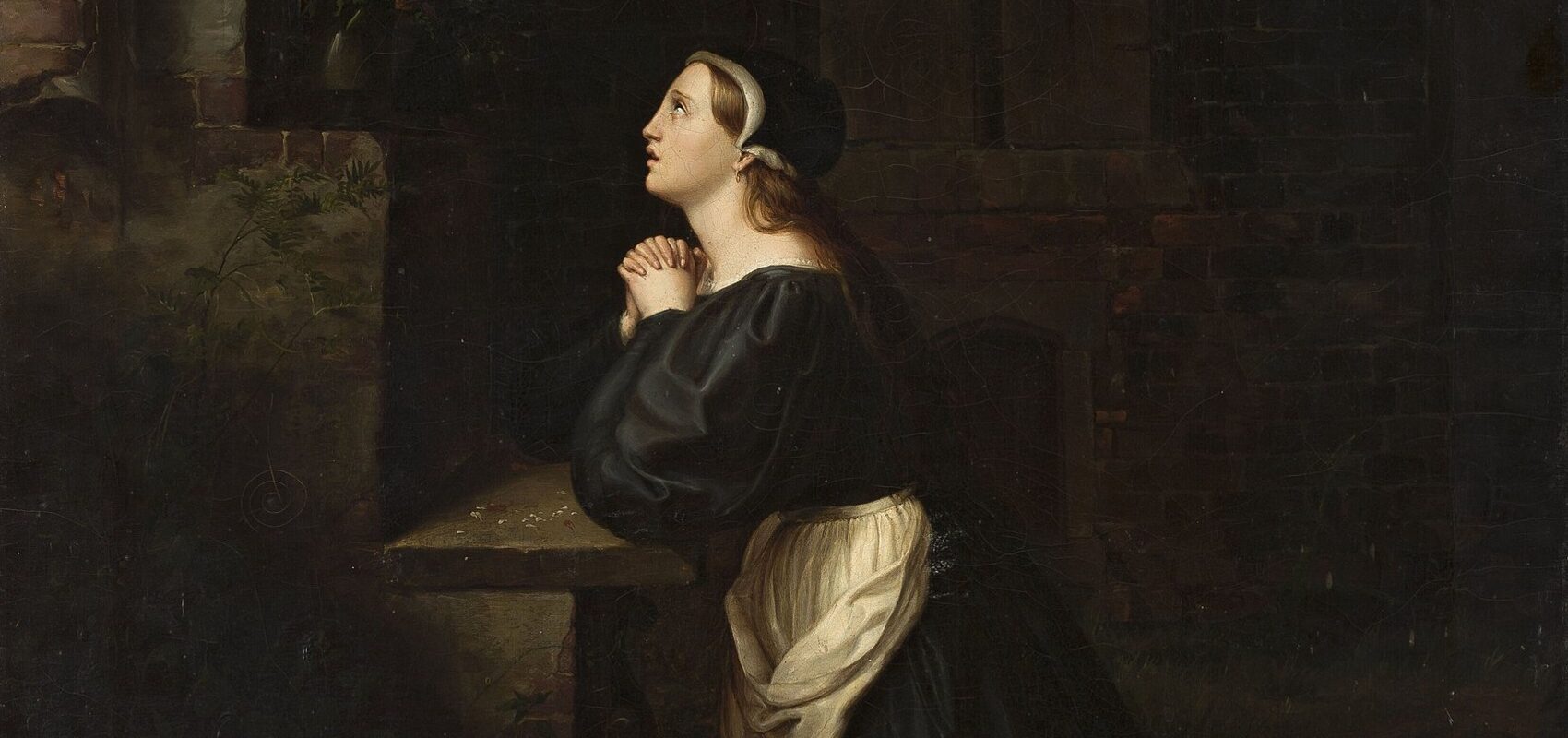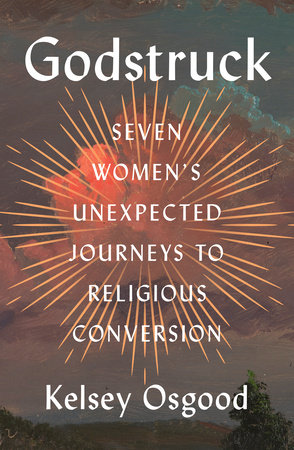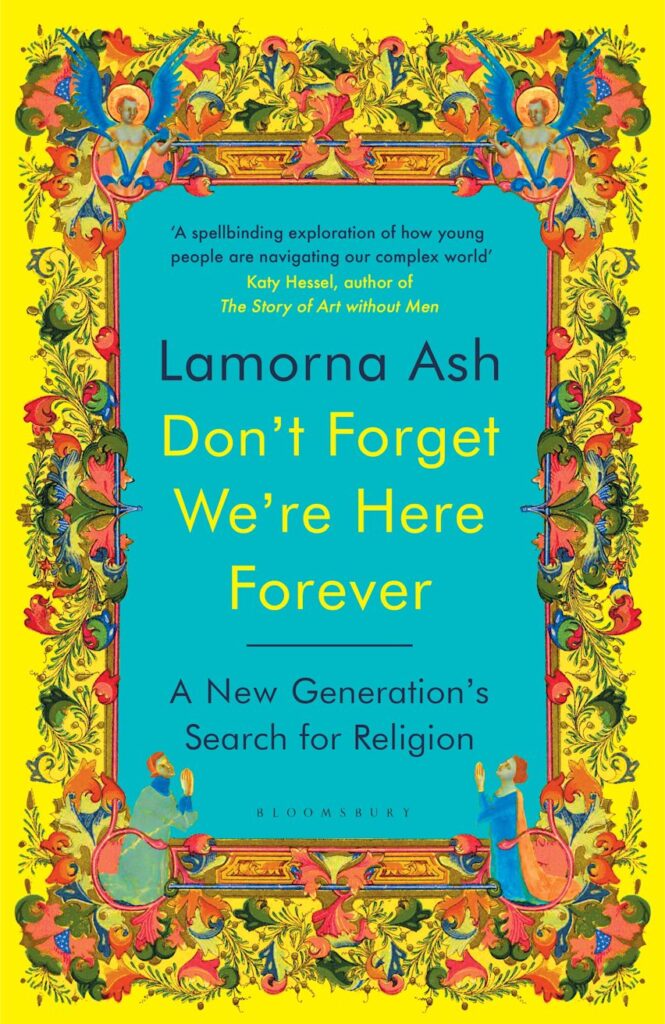
Don’t Forget We’re Here Forever:
A New Generation’s Search for Religion
by lamorna ash
bloomsbury, 352 pages, $29.99
Godstruck:
Seven Women’s Unexpected Journeys to Religious Conversion
by kelsey osgood
penguin, 352 pages, $30
When the agnostic Swiss playwright and novelist Max Frisch died, he asked that his funeral be conducted in St. Peter’s Church in Zurich. But certain conditions applied: The service would be stripped of any religious trappings. A couple of friends would speak. No priest would bless the mourners. No prayers would be offered. No passages from the Bible or the Book of Common Prayer would be read.
Among the friends in attendance was the philosopher Jürgen Habermas. The contradiction struck him so forcefully that he used it to open his now famous essay The Awareness of What Is Missing. He saw the funeral as the perfect paradoxical embodiment of the modern age: a church acceding to a service with no “Amen”; an irreligious dead man conceding that there was no more suitable building in which to display his coffin.

A new Pew Research study reports that at least a fifth of the adults in many countries across Europe, the Americas, and East Asia are leaving their childhood religions. By and large, this is a movement of disaffiliation, towards no other tradition in particular. Christianity is seeing particularly heavy losses, with a ratio of about six people leaving for every new convert in the States, and as many as nine to one in the UK.
At the same time, a recent Bible Society report brings hope of a “quiet revival” among British Gen Zers, particularly in Catholic and Pentecostal churches. And among the public intellectual class, there has been a distinct sense, if not of revival, of at least a kind of thaw, catalogued hopefully by writers like British Christian broadcaster Justin Brierley in his book The Surprising Rebirth of Belief in God.
Two new books take the reader beyond the pie charts and broad surveys. Instead of statistics, they offer stories. Their subjects have no name recognition, no podcasts or books to sell. They are ordinary young men and women in various states of spiritual rest and unrest. Some have found their rest in Christianity; others have sought it elsewhere. And among those who claim to be Christians, there are chasmic differences on doctrine and ethics. But whether consciously or subconsciously, all share the same hunger.
In Godstruck, Kelsey Osgood offers intimate portraits of six American women who have each embraced a different religious faith in adulthood, mostly abandoning the traditions (if any) they were handed in childhood. She weaves these stories together with the story of her own conversion to Orthodox Judaism. In Don’t Forget We’re Here Forever, Lamorna Ash invites the reader to travel with her across the UK, interviewing young people who identify as conservative Christians, liberal Christians, or some nebulous “other.” She focuses on Christianity because it’s the only faith with “any hold” on her own biography, through her paternal grandmother, the family’s last “true Christian.” As for herself: Well, it’s complicated.
The women profiled by Osgood are Angela, a California rationalist drawn to Quakerism; Sara, once a nominal Catholic, now a passionate charismatic evangelical; Kate, also drawn away from nominal Catholicism and into Mormonism; Hana, an orphan who turned to Islam; Christina, attracted to the radical renunciation undertaken by the Amish; and Orianne, the only subject with some continuity between her Catholic childhood and her adult vocation as a nun. Then there is Osgood herself, claiming no Jewish heritage by blood, yet claiming it by adoption—and not just any form of Judaism, but the most difficult, demanding form she could bear. She observes her fellow spiritual travelers with a shrewd and sympathetic eye, half maternal, half sisterly.
By contrast, Ash writes with the voice of the troubled wanderer, still seeking and not yet finding. The shape of her irreligion is distinctively evangelical: She is frustrated when her subjects believe things that, by her lights, aren’t true. She may be less than certain what she means when she declares her intention to prove “that religion still matters enormously,” but she retains fixed points for what it cannot mean. It can’t mean a rejection of higher-critical assumptions about Scripture. It can’t mean an embrace of Christian doctrine as anything more reasoned than a wild Kierkegaardian leap. And it certainly can’t mean an adherence to traditional sexual ethics.

Ash’s biases have been lamented in a sharp review of the book by one of its subjects, Jack Chisnall, whom Ash shadowed while he was discerning the Anglican priesthood. Despite Ash’s announcement that she is witnessing a new thing, Chisnall perceives that she is just playing the latest variation on the tune sung down the centuries by Schleiermacher, Schweitzer, Spong, and many more. (The final third of her book features millennial deconverts clutching dog-eared copies of Richard Rohr and Brian McLaren.) And yet it was really Jack who launched her quest. They are like estranged siblings, parting ways as the path forks. Young Jack warns young Lamorna that, in the great house of your life, there is not one room on whose door God will not come knocking. But in Lamorna’s house, some doors remain locked.
Osgood, by contrast, points to a study showing that some “nones” were intrigued by an immersive six-month retreat with nuns. The vows, including chastity, exerted an appeal for an anxious generation slowly discovering that life lived without moral boundaries hasn’t made them as free as they thought it would. Even Ash confesses the occasional doubt concerning her bisexual experiments as she encounters serene religious sisters and guileless young missionary couples. She uneasily apprehends that, as Zena Hitz puts it, sex is “more than chewing bubble gum.”
In the end, the bravest heroes of Ash’s story are the most transgressive, especially gender-bending women like “Tom” and “Robert.” Their version of Jesus is far more “worldly” and affirming than that of the conservative evangelist who “likes where the rules are” in Scripture and (shockingly) thinks sin is a worse problem than climate change. In a didactic digression on official Catholic statements about transgenderism, Ash echoes Andrew Sullivan’s complaints about then-Cardinal Ratzinger’s Pastoral Letter On Homosexuality. Both make progressive revisionism a sine qua non of “human dignity.” In their role as self-anointed prophets, they are here to inform the Church that there is a new drumbeat. March to it now, or be left behind.
As for Osgood, casual hookups were never her besetting temptation in the first place. But in a thousand other ways, large and small, she asks not what Judaism can do for her, but what she can do for Judaism. When young Kelsey first begins exploring synagogues, she feels patronized by the “God-optional” choices, by their “kowtowing to presentism,” their conversion processes offering “all the spiritual sustenance of being a product on a conveyor belt.” She will have the real thing, or nothing at all.
Osgood tenderly traces her evolution from pious child rapturously caught up in church and nature—like some cherubic Victorian moppet—to precociously hardened little atheist, deciding at age eight that it was time to put away childish things. There followed “thirteen years of silence,” in which she taunted her believing friends only because she was terrified that she had trapped herself “alone with nothingness.” Today, she finds herself a Jewish wife and mother of two. She has been forced to surrender her wanderlust, her laziness, and the obsessive self-absorption that fueled her anorexia. As she keeps and is kept by Shabbat, as she attends to the rhythms of making her challah and saying her prayers, her gaze is drawn perpetually outward, upward. Her soul delights in the command for the command’s sake, even when it is a mystery.
The necessity of mystery is one point of commonality between Osgood and Ash, as both reject the idea of a faith that is fully comprehensible or reasonable. Though Osgood does emphasize that pragmatism can’t sustain religious conversion without a spark of true belief, she’s not too concerned with the objective justification of any one belief in particular. Her profiles of Sara and Kate, the charismatic evangelical and the Mormon, trace similar arcs. Neither woman seems to have an epistemological framework that can sustain her beyond the experiential. Both women watch and wait for a burning in their bosoms. Both enter communities full of earnest young people who declare their closeness to Jesus with passionate intensity. Osgood can’t exactly relate, as her own personality is more cerebral than emotive. But she believes she and her subjects are all in the same epistemological boat, and she agrees with her rationalist-Quaker friend Angela that the magisteria must not overlap. We all of us must choose our narratives “in the absence of any meaningful data proving or disproving some transcendent force.” Without such data, free to pick, why wouldn’t you “pick the open one, the hopeful one, the magical one”?
The phrase “proving or disproving” requires teasing out. It may be true that God’s existence—where by “God” we mean Hashem, God of the patriarchs and the prophets, God who became God with us, God hanging on a tree and rising bodily on the third day—can’t be mathematically “proved.” Even if one might attain something like logical certainty for the existence of a personal First Cause, further revelations require more than the tools of deduction. This need not mean that the tools of reason are unavailable or ineffective when we consider the divine. Osgood’s Catholic nun, Orianne, offers an intuitive version of the argument from beauty, which she first formulated as a child. Later, comparing Christianity and Islam, she recalls deciding that the hanging God is worthier of worship than the God who scorns crucifixion—an observation that could be sharpened as an argument from maximal goodness. Granted, Orianne never thinks of herself as making arguments, premise-and-conclusion style. But her common sense can be made rigorous.
This is not to deny that intellectual justification has its limits, particularly as the chain of custody from divine Word to recorded word to modern reader becomes difficult to trace. But it seems safe to say that the God of the Bible is a God who was concerned with preserving a record of his earthly dealings, most intimately and particularly his incarnation. If the gospels do not constitute “meaningful data,” then what exactly are they? How are we to receive a verse such as John 19:35, on the piercing of Jesus’s side through the eyes of the beloved disciple: “And he that saw it bare record, and his record is true: and he knoweth that he saith true, that ye might believe”?
Ultimately, we cannot avoid the business of testing, weighing, and judging. Not because we are pursuing a “proof,” in the purest sense, but in that we are gathering evidence, making a case—a process to which we seem to have been positively invited.
On one level, this is the invitation extended in Ross Douthat’s recent book Believe, which energetically argues that God probably exists and that you, dear religiously non-committed reader, should probably get busy with some form of worship. But Douthat’s hopeful prescription becomes fuzzier when it comes to the question of the particular shape that worship should take. As a Catholic, he would prefer that everyone worship the Christian God, and his final chapter homes in unapologetically on the case for Christ. At the same time, he explains that he will still be happy if he can inspire his readers to take up some religion of some kind. Were he to read Osgood’s book, he would see in all her subjects an admirable movement toward the religious traditions that feel most accessible and make the most sense in their particular circumstances. To that extent, he and Osgood, the post– Vatican II Catholic and the Jew, are kindred latitudinarian spirits. I, by contrast, though I don’t qualify strictly as “evangelical,” might in a certain ironic, photo-negative sense share more DNA with Ash. One could say that we are cut from the same Protestant cloth.
Ash’s book finds some of its most poignant moments in reflections on prayer. Certain kinds of prayer she judges hypocritical (such as praying outside abortion clinics), but she’s touched in spite of herself by those charismatic Christians who approach the throne with all the boldness of people who believe the apostolic age never ended. Yet here she also finds the quiet teenager with chronic pain, no longer able to bear having her friends pray over her, grateful at least that God has allowed her to “walk alongside other broken people.” At various points, people offer Ash prayers and “words from the Lord,” which she receives with a mix of emotion and bemusement.
In one sweet vignette, she allows an earnest boy to petition the Lord for a reduction in her tooth pain from a receded gum. “Imagine if it had gone,” she reflects. Would she have fallen off her chair and become a Christian? Would she have believed? My mind went back to a conversation I once had with Douglas Murray and Justin Brierley, in which Brierley asked Murray what, if anything, could nudge him decisively towards Christianity. Douglas answered, “I think I would need to hear a voice.” Had I been expecting this answer, I would have asked him what he wanted the voice to say.
It is near the end that Ash’s story takes its darkest and most unexpected turn, when her mother is diagnosed with Alzheimer’s. And so, irrevocably, the world changes. The sky darkens. Her mind is “in hell.” Only then does she learn to pray. And wherever she finds herself walking now, down whatever unfamiliar street, she cannot pass a church without slipping inside. “Often their doors are open. Mostly their pews are empty.”
Osgood also writes vulnerably about the early days of her struggle with secondary infertility, which is on her mind as she listens to a charismatic pastor preach about the woman with an issue of blood. Her evangelical friend Sara, fighting diabetes, goes to the front for a laying on of hands, wistfully hoping this might be the Sunday she receives healing. Osgood doubts, but she doubts with compassion. For she prays, too, all the time. “What I get, of course, is silence.” This is not a bitter statement. In some sense, it is a profoundly Jewish statement. One thinks of Reb Saunders in Chaim Potok’s The Chosen, raising his son in silence so that one day he will understand the silence of God. Yet, even amid God’s silence, Osgood remembers that she was at peace. God did not heal her infertility, but she dared to believe “something useful was happening nonetheless . . . a great tapping into something universal and bottomless, an acknowledgment that despite the contemporary hubris that we can eradicate human pain, it would always be there, assaulting us, molding us, wearying us, carrying us.”
“Let it get worse, because it will,” Ash prays, “but let that not break us. Let it not hurt her. Let us take it in and let it be.” “I am a person lost in the wilderness,” Osgood prays. “Hear me. Help me.”
And indeed, she declares, “He does.”

